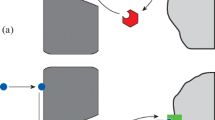Abstract
The sensitivity of a warm cell to temperature stimulation was examined electrophysiologically on the spider Cupiennius salei. The relationship between sensitivity and structure of the warm cell was assessed by comparing both the electrophysiological and electron-microscopic data with those described for insect cold cells. Stimulation of the spider warm cell with slowly oscillating temperature change and steady temperature elicited less sensitive responses than in insect cold cells. These characteristics are reflected in the size of the dendritic membrane area, which is smaller in the spider warm cell compared to the insect cold cells. Rapid step-like temperature change produced in the spider warm cell very sensitive responses when compared with data of insect cold cells. The dendritic tip of the spider warm cell is exposed at a pore on the tip of the sensillum but is covered by the cuticle of the sensillum in the insect cold cells.
Similar content being viewed by others
References
Altner H, Loftus R (1985) Ultrastructure and function of insect thermo- and hygroreceptors. Annu Rev Entomol 30: 273–295
Ameismeier F, Loftus R (1988) Response characteristics of cold cell on the antenna of Locusta migratoria L. J Comp Physiol A 163: 507–516
Anton S, Tichy H (1994) Hygro- and thermoreceptors in tip pore sensilla of the tarsal organ of the spider Cupiennius salei: innervation and central projection. Cell Tissue Res 278: 399–407
Blumenthal H (1935) Untersuchungen über das “Tarsalorgan” der Spinnen. Z Morphol Ökol Tiere 29: 667–719
Braun HA, Schäfer K, Wissing H (1990) Theories and models of temperature transduction. In: Bligh J, Voigt K (eds) Thermoreception and temperature regulation. Springer, Berlin/Heidelberg New York, pp 19–29
Corbière-Tichané G (1971) Structure nerveuse énigmatique dans l'antenne de la larve du Speophyes lucidulus Delar. (Coléoptère cavernicole de la sous-famille des Bathysciinae). Étude au microscope électronique. J Microscopie 10: 191–202
Corbière-Tichané G, Loftus R (1983) Antennal thermal receptors of the cave beetle, Speophyes lucidulus Delar. II. Cold receptor response to slowly changing temperature. J Comp Physiol 153: 343–351
Ehn R, Tichy H (1994) Hygro- and thermoreceptive tarsal organ in the spider Cupiennius salei. J Comp Physiol A 174: 345–350
Haug T (1986) Struktur, Funktion und Projektion der antennalen Thermo- und Hygrorezeptoren von Antheraea pernyi (Lepidoptera: Saturniidae). Doctoral Dissertation, University of Regensburg
Loftus R (1968) Response of the antennal cold receptor of Periplaneta americana to rapid temperature changes and to steady temperature. Z Vergl Physiol 59: 413–455
Loftus R (1969) Differential thermal components in the response of the antennal cold receptor of Periplaneta americana to slowly changing temperature. Z Vergl Physiol 63: 415–433
Loftus R, Corbière-Tichané G (1981) Antennal warm and cold receptors of the cave beetle, Speophyes lucidulus Delar., in sensilla with a lamellated dendrite. I. Response to sudden temperature change. J Comp Physiol 143: 443–452
Loftus R, Corbière-Tichané G (1987) Response of antennal cold receptors of the catopid beetles, Speophyes lucidulus Delar. and Choleva angustata Fab. to very slowly changing temperature. J Comp Physiol A 161: 399–405
Tichy H (1987) Hygroreceptor identification and response characteristics in the stick insect Carausius morosus. J Comp Physiol A 160: 43–53
Yokohari F (1981) The sensillum capitulum, an antennal hygro- and thermoreceptive sensillum of the cockroach, Periplaneta americana L. Cell Tissue Res 216: 525–543
Zimmermann B (1991) Differentiation of the thermo-/hygrosensitive (no-pore) sensilla on the antenna of Antheraea pernyi (Lepidoptera, Saturniidae): a study of cryofixed material. Cell Tissue Res 266: 427–440
Author information
Authors and Affiliations
Additional information
Dedicated to Richard Loftus on the occasion of his 70th birthday, who pioneered several of the questions addressed in this study
Rights and permissions
About this article
Cite this article
Ehn, R., Tichy, H. Response characteristics of a spider warm cell: temperature sensitivities and structural properties. J Comp Physiol A 178, 537–542 (1996). https://doi.org/10.1007/BF00190183
Accepted:
Issue Date:
DOI: https://doi.org/10.1007/BF00190183




